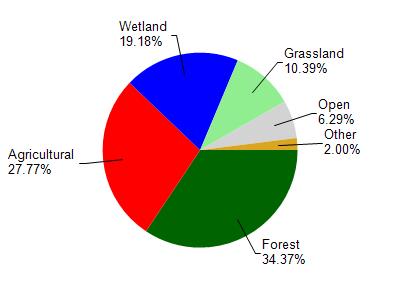Waushara
No
No
No
Fish and Aquatic Life
Overview
Little Hills Lake, in the Pine and Willow Rivers Watershed, is a 78.45 acre lake that falls in Waushara County. This lake is managed for fishing and swimming and is currently not considered impaired.
Date 2011
Author Aquatic Biologist
Historical Description
Source: 1970, Surface Water Resources of Waushara County Hills Lake, Little T18N, R11E, Sections 8, 9 Surface Acres = 80.7; S.D.F. = 1.19, Maximum Depth = 23.0 feet.
A medium-sized lake located in the Town of Marion (not to be confused with Hills Lake in the town of Mt. Morris). This lake is landlocked and exhibits a fairly irregular basin, especially along the southern shoreline. About 15 percent of the surface area of the lake is characterized by depths greater than twenty feet. The littoral bottom materials consist primarily of sand and muck. The primary water source of the lake is seepage, with a few internal springs which do not flow sufficiently to replace the volume of the lake. The drainage area of the lake is approximately one square mile, much of it being wooded or wild. Five percent of the watershed is in agricultural use. The fishery consists of northern pike, walleye, perch, largemouth bass, bluegills, black crappie, green sunfish and channel catfish. Fluctuating water levels interfere with the recreational use of the lake. Development along the shoreline consists of 35 cottages or dwellings. Public access is available from one town road. Waterfowl make some use of the area during spring and fall migrations. Up to 100 birds (mallards and bluewing teal) have been observed during these periods.
Date 1970
Author Surface Water Inventory Of Wisconsin
General Condition
Little Hills Lake (105200) was assessed during the 2016 listing cycle; total phosphorus and chlorophyll sample data were clearly below 2016 WisCALM listing thresholds for the Recreation use and Fish and Aquatic Life use. This water was also assessed for chlorides and sample data were clearly below 2016 WisCALM chronic and acute listing criteria for the Fish and Aquatic Life use. This water is meeting these designated uses and is not considered impaired.
Date 2015
Author Ashley Beranek
Condition
Wisconsin has over 84,000 miles of streams, 15,000 lakes and milllions of acres of wetlands. Assessing the condition of this vast amount of water is challenging. The state's water monitoring program uses a media-based, cross-program approach to analyze water condition. An updated monitoring strategy (2015-2020) is now available. Compliance with Clean Water Act fishable, swimmable standards are located in the Executive Summary of Water Condition in 2018. See also the 'monitoring and projects' tab.
Reports
Management Goals
Wisconsin's Water Quality Standards provide qualitative and quantitative goals for waters that are protective of Fishable, Swimmable conditions [Learn more]. Waters that do not meet water quality standards are considered impaired and restoration actions are planned and carried out until the water is once again fishable and swimmable
Management goals can include creation or implementation of a Total Maximum Daily Load analysis, a Nine Key Element Plan, or other restoration work, education and outreach and more. If specific recommendations exist for this water, they will be displayed below online.
Monitoring
Monitoring the condition of a river, stream, or lake includes gathering physical, chemical, biological, and habitat data. Comprehensive studies often gather all these parameters in great detail, while lighter assessment events will involve sampling physical, chemical and biological data such as macroinvertebrates. Aquatic macroinvertebrates and fish communities integrate watershed or catchment condition, providing great insight into overall ecosystem health. Chemical and habitat parameters tell researchers more about human induced problems including contaminated runoff, point source dischargers, or habitat issues that foster or limit the potential of aquatic communities to thrive in a given area. Wisconsin's Water Monitoring Strategy was recenty updated.
Grants and Management Projects
Monitoring Projects
| WBIC | Official Waterbody Name | Station ID | Station Name | Earliest Fieldwork Date | Latest Fieldwork Date | View Station | View Data |
|---|
| 105200 | Hills Lake | 703102 | Little Hills Lake - NE Lobe - Deep Hole | 4/25/1998 | 3/31/2024 | Map | Data |
| 105200 | Hills Lake | 10045244 | Phragmites Occurrence - Hills Lake | 7/15/2015 | 9/30/2017 | Map | Data |
| 105200 | Hills Lake | 703031 | Little Hills Lake - West Lobe Deep Hole | 8/28/1995 | 9/18/2025 | Map | Data |
| 105200 | Hills Lake | 10040981 | Little Hills Lake - Monitoring Well | 8/16/2013 | 3/30/2024 | Map | Data |
| 105200 | Hills Lake | 10019594 | Little Hills Lake -- Access | 8/3/2001 | 7/1/2020 | Map | Data |
| 105200 | Hills Lake | 10007403 | Little Hills Lake | 7/27/1999 | 3/7/2024 | Map | Data |
|

Watershed Characteristics
Hills Lake is located in the Pine and Willow Rivers watershed which is 302.08 mi². Land use in the watershed is primarily forest (34.40%), agricultural (27.80%) and a mix of wetland (19.20%) and other uses (18.70%). This watershed has 377.48 stream miles, 11,273.01 lake acres and 33,136.61 wetland acres.
Nonpoint Source Characteristics
This watershed is ranked High for runoff impacts on streams, Not Ranked for runoff impacts on lakes and High for runoff impacts on groundwater and therefore has an overall rank of High. This value can be used in ranking the watershed or individual waterbodies for grant funding under state and county programs.However, all waters are affected by diffuse pollutant sources regardless of initial water quality. Applications for specific runoff projects under state or county grant programs may be pursued. For more information, go to surface water program grants.